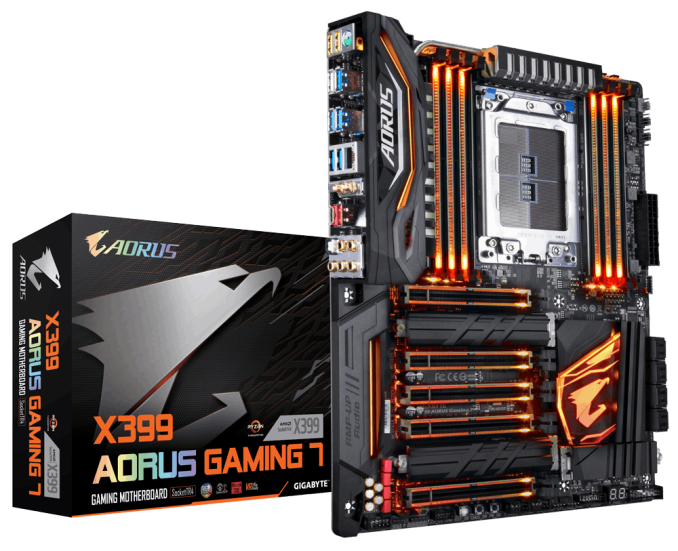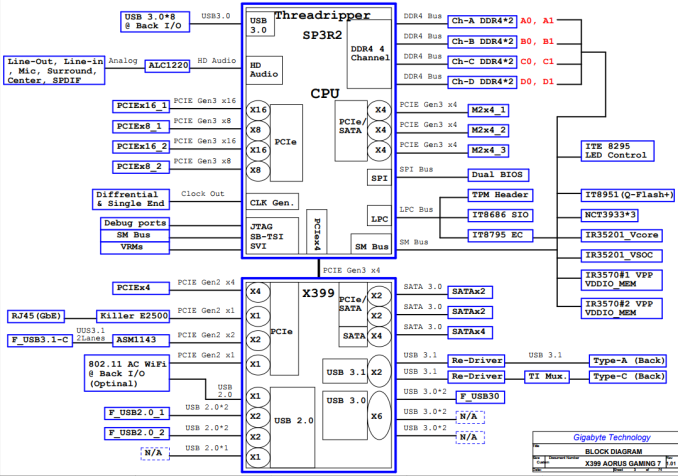An AMD Threadripper X399 Motherboard Overview: A Quick Look at Seven Products
by Ian Cutress & Joe Shields on September 15, 2017 9:00 AM ESTGIGABYTE
GIGABYTE's initial entry into the Threadripper platform is the X399 AORUS Gaming 7, formally placing the name AORUS into the motherboard listing. In GIGABYTE’s typical product stack of Gaming X versions, models usually have a 3, a 5, a 7 or a 9 at the end. With this one being a Gaming 7, it stands to reason that GIGABYTE might have something for the more extreme Threadripper audience in a future Gaming 9, or a product easier on the wallet in a future Gaming 3. For now, the X399 AORUS Gaming 7 stands alone, although the specifications ensure that it is one of the higher-end products at launch.
Edit: We've been informed that GIGABYTE has an X399 Designare on the way!
X399 AORUS Gaming 7
If the promotional shots are anything to go buy, GIGABYTE is adamant that you must know that the motherboard has RGB LEDs, and it has them almost everywhere. Between the DRAM slots, on all the PCIe slots, through a transparent plastic shield on the chipset heatsink, on the audio shield, and on the IO cover. If you thought RGB was kitsch, then the Gaming 7 is a one way ticket to kitsch central.
As with the other boards in this roundup, quad channel memory at two DIMMs per channel is the name of the game for the socket area, and similarly we get a power delivery system that uses a main heatsink connected to a secondary heatsink by the rear IO via a heatpipe, but carefully hidden under the rear IO vanity plate. In a plus point to marketing, GIGABYTE is listing its power delivery as ‘server class’, using fourth generation International Rectifier (IR) PWM controllers and third generation PowIRstage chokes. The EPS connectors for the power delivery are found in the top left corner of the board, with one 8-pin and one 4-pin.
On the top right of the board is an array of five 4-pin fan headers, paired with an RGBW header marking GIGABYTE’s different approach to added RGB LED connectivity. There other 4-pin fan headers on board, with at least two on the bottom, again with another RGBW header. Speaking of headers, USB connectivity comes through an onboard USB 3.1 (10 Gbps) header from the chipset near the eight SATA ports, a USB 3.0 header on the bottom of the board, two USB 2.0 headers near the power buttons also on the bottom of the board, and a TPM header.
One of the headline features on the Gaming 7 is the support for three M.2 drives, as shown in the image above. The two areas for M.2 drives between the PCIe slots support 110mm long drives, while the area below the heatsink supports a more standard 80mm drive. All three of these M.2 slots come with additional heatsinks, providing a better thermal environment for any drive and not disturbing the aesthetic of the system. Compared to other motherboards, GIGABYTE has implemented this arrangement rather than pursue a separate (or switched) U.2 connector. For other storage, GIGABYTE has equipped the board with eight SATA ports.
The PCIe slot arrangement, despite having every slot with additional RGB and slot reinforcement, only four of these slots are direct from the CPU for peak graphics duty. The slots that are doubly spaced support an x16/x8/x16/x8 arrangement, with the middle slot supporting a separate PCIe 3.0 x4 connection through the chipset. The idea is that the middle slot can be used for an add-in card, such as 10 gigabit Ethernet or additional connectivity while using two GPUs.
Next to the PCIe slots is GIGABYTE’s audio solution, using the Realtek ALC1220 audio codec and implementing an EMI shield, PCB separation for digital and analog signals, filter caps and headphone jack detection. GIGABYTE also likes to promote DAC-UP, ensuring a more consistent USB power delivery port for USB connected audio devices. It’s not necessarily a unique feature, although it rarely gets marketing attention on other motherboards.
Connectivity on the rear IO panel shows one of the few motherboards with a PS/2 port, which can be useful in some environments. Due to the support for USB 3.0 from the CPU, the rear panel has a full set of eight USB 3.0 ports, in yellow, blue and a white color. There is also two USB 3.1 (10 Gbps) ports from the chipset, one of which is USB Type-C. Network connectivity is provided by a Rivet Networks Killer E2500 and a WiFi solution, and at the end are a set of audio jacks.
GIGABYTE supplied a chipset/block diagram as well to show the lane routing on the Gaming 7:
| GIGABYTE X399 AORUS Gaming 7 | |
| Warranty Period | 3 Years |
| Product Page | Link |
| Price | $389.99 |
| Size | ATX |
| CPU Interface | TR4 |
| Chipset | AMD X399 |
| Memory Slots (DDR4) | Eight DDR4 Supporting 128GB Quad Channel Support DDR4 3600+ Support for ECC UDIMM (operates in non-ECC mode) |
| Network Connectivity | 1 x Rivet Networks Killer E2500 LAN 1 x Intel 2x2 802.11ac |
| Onboard Audio | Realtek ALC1220 |
| PCIe Slots for Graphics (from CPU) | 2 x PCIe 3.0 x16 slots @ x16 2 x PCIe 3.0 x16 slots @ x8 |
| PCIe Slots for Other (from Chipset) | 1 x PCIe 2.0 x16 slots @ x4 (PCIeX4) |
| Onboard SATA | 8 x Supporting RAID 0/1/10 |
| Onboard SATA Express | None |
| Onboard M.2 | 3 x PCIe 3.0 x4 - NVMe or SATA |
| Onboard U.2 | None |
| USB 3.1 | 1 x Type-C (ASMedia) 1 x Type-A (ASMedia) |
| USB 3.0 | 8 x Back Panel 1 x Header |
| USB 2.0 | 2 x Headers |
| Power Connectors | 1 x 24-pin EATX 1 x 8-pin ATX 12V 1 x 4-pin ATX 12V |
| Fan Headers | 1 x CPU 1 x Watercooling CPU 4 x System Fan headers 2 x System Fan/ Water Pump headers |
| IO Panel | 1 x PS.2 keyboard/mouse port 1 x USB 3.1 Type-C 1 x USB 3.1 Type-A 8 x USB 3.0 1 x RJ-45 LAN Port 1 x Optical S/PDIF out 5 x Audio Jacks Antenna connectors |



















99 Comments
View All Comments
Holliday75 - Friday, September 15, 2017 - link
Where is this magical land?ddriver - Friday, September 15, 2017 - link
Actually, many people in the developed world call a technician for even trivial things like changing a fuse. Building a computer, as simple as it is, is out of this world achievement in their eyes.mapesdhs - Tuesday, September 19, 2017 - link
Weird, normally such a person wouldn't even ask a relevant question. My gf doesn't care what my HTPC has inside, as long as it runs YT and plays DVDs, etc. ok, and she can use the wifi link to find stuff for her Kindle.mapesdhs - Tuesday, September 19, 2017 - link
NB: I was replying to ddriver saying, "So a dumb wife having to approve your purchases is a realistic scenario? :D".Vatharian - Friday, September 15, 2017 - link
No anything that has more than 2 HDDs is a server. I also have gaming PC that has 10 HDDs. They are low capacity, and connected to low-end HBA, but this way I won't ever lose any data. And I just can't think of a reason to pay well over $1000 for 10 disk-capable NAS.ddriver - Friday, September 15, 2017 - link
You really must love noise then, and waste power. Besides, the more drives, the more drives, the higher the odds some of them die. You can get a couple of large HGST drives, huge capacity, excellent reliability. The odds of both drives failing is minuscule, and would require the entire system burning up, which would be just as devastating regardless of many drives you have. You don't require 10 drives for the sake of the number. 10 TB HGST HE10 are like 350$.Besides, TR doesn't fall neither in the "budget", nor in the "gaming" category. That's a workstation CPU, and it actually does pretty bad in gaming, considering its price. Paying that much money for a product you are not gonna use for the job it is best at and complaining the mobo doesn't fit your senseless and wrong usage scenario - that's kinda dumb.
It is a new high end product, you are gonna put new high end components in it, not 10 poor old tiny HDDs.
Guwapo77 - Saturday, September 16, 2017 - link
It's not bad at gaming, however, it is not wise to use this solely for gaming. A workstation that you can use to handling your day to day workload that just happens to be fairly decent for gaming when you have time.Anyone building a gaming rig that chooses to buy a TR fails at life.
cyberguyz - Thursday, December 28, 2017 - link
It has 2x M.2 slots not 3x. You need an add-in card to get the 3rd with this onefazalmajid - Sunday, September 17, 2017 - link
Annoying, but a LSI add-in HBA will generally outperform integrated SATA by a wide margin.karatekid430 - Thursday, October 26, 2017 - link
Ask the manufacturers to make M.2 PCIe cards with a SATA controller and a heap of SATA ports on board. I want them to provide these, and exclude SATA from motherboards, to save space and reduce complexity and cost. That way, the motherboards are cleaner for people who only require NVMe, and allow for people who need SATA to sacrifice M.2 slots for SATA.